
Seven Stages for Crafting Holy Kaaba’s Kiswa by Skilled Saudi Hands
With skilled Saudi hands that have mastered the art of weaving beauty into the Holy Kaaba’s Kiswa using threads of silk, silver, and gold, a team of vibrant young Saudis carry out the process of crafting the Kiswa through seven distinct stages.
The process begins with the refining stage, which involves preparing purified water to specific standards for washing and dyeing the silk. The second stage includes washing and dyeing the silk—removing its protective wax layer and dyeing it black for the external Kiswa and green for the inner Kiswa and the Prophet’s Chamber—followed by drying in specialized dryers.
The third stage is automated weaving, where both patterned and plain silk fabrics for the Kiswa and its inner lining are produced. Silk threads are transformed from skeins into warp beams containing more than 9,900 threads per meter. These are then mounted on weaving machines: patterned silk for the outer Kiswa and plain silk for printing and embroidering Quranic verses.
The fourth stage is printing, where plain silk fabric is fixed onto the loom and Quranic verses are printed with precise geometry using screen printing (silk screen) for the Kiswa’s belt, the panels beneath the belt, the lantern-shaped motifs, the "Samadiyyah" panels, and the curtain of the Kaaba’s door.
In the fifth stage, assembly and stitching, the Kiswa pieces are connected and stitched together, including the assembly of the Kaaba’s door curtain. The gilded pieces are affixed, such as the belt and panels beneath it.
The sixth stage is embroidery of the gilded elements, where Quranic verses and Islamic motifs are embroidered with silver threads, some of which are plated with gold. These designs are padded with cotton threads to highlight the letters and patterns.
The seventh and final stage is quality control, ensuring that all inputs and outputs meet the required standards of the complex. Every stage of production undergoes thorough inspection to guarantee the highest quality before installation.
Finally, the Kiswa is draped over the Kaaba in a ceremonial process conducted annually on the first day of Muharram. Each side of the Kaaba is covered individually, the four sides are stitched together at the corners and bottom, and the door curtain is then installed.
Tomorrow, the Holy Kaaba will witness the annual ceremony of replacing its Kiswa, carried out by 154 technicians and craftsmen, who will raise the new Kiswa and lower the old one in line with Hijri tradition.








